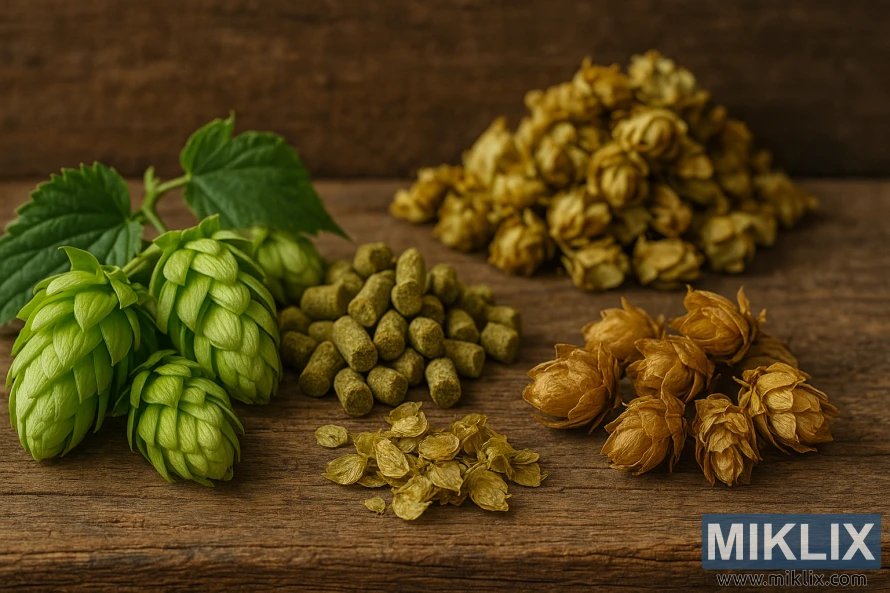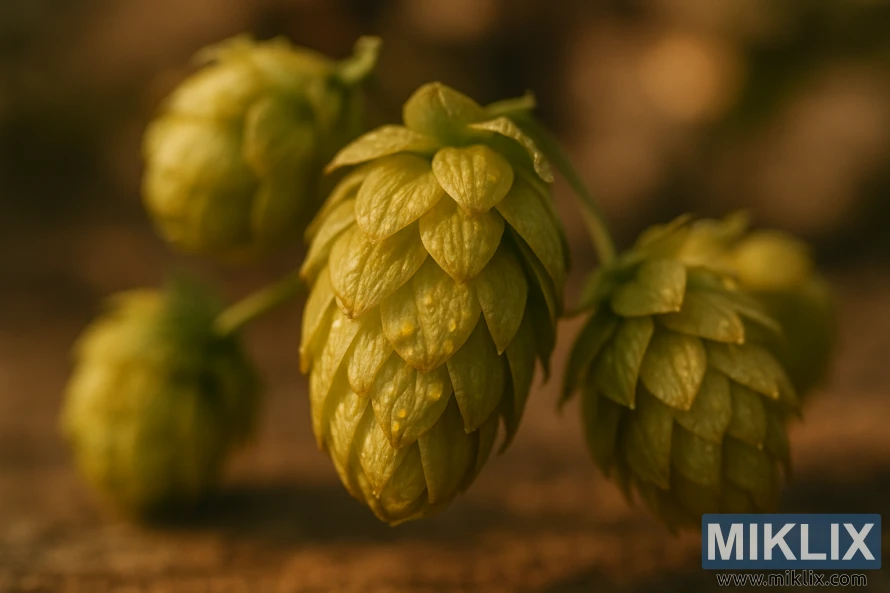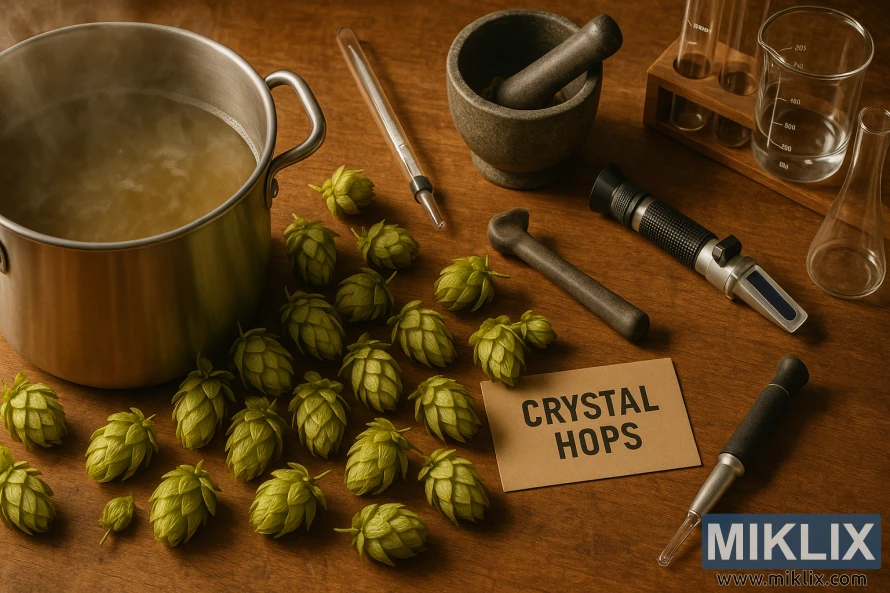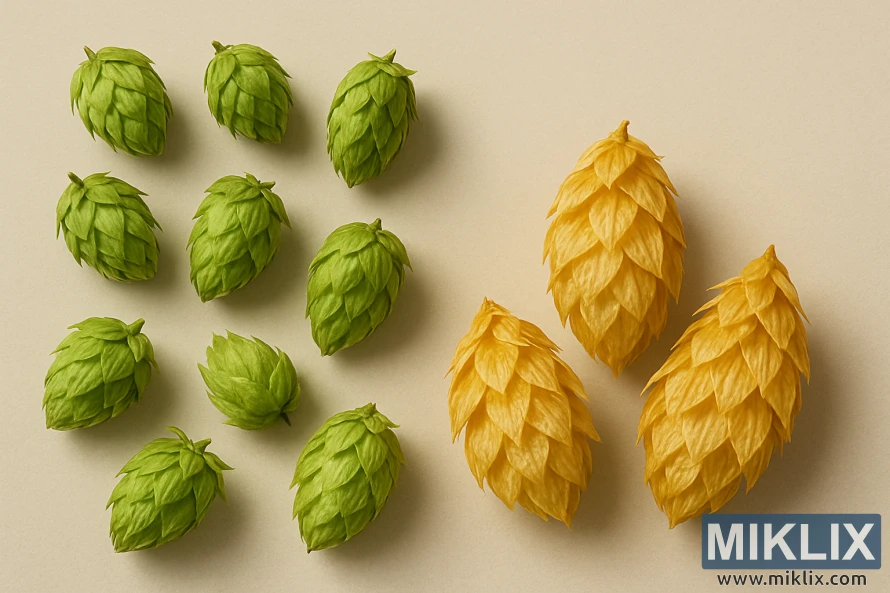Hops in Beer Brewing: Crystal
Published: August 16, 2025 at 8:41:16 PM UTC
Beer brewing has seen a significant transformation with the advent of diverse hop varieties. Each variety brings its own set of flavors and aromas. Crystal Hops stand out, known for their unique traits, making them a favorite among brewers. Crystal Hops are a result of crossing Hallertau Mittelfrueh with other notable hop varieties. They are celebrated for their exceptional aroma and flavor. This versatility allows brewers to explore a wide range of beer styles, from lagers and ales to IPAs. It opens up new possibilities for experimenting with recipes and flavors.

Key Takeaways
- Crystal Hops offer a unique flavor and aroma profile.
- They are versatile and can be used in various beer styles.
- Their characteristics make them suitable for both traditional and innovative brewing.
- Crystal Hops are a result of crossing Hallertau Mittelfrueh with other hop varieties.
- They enhance the brewing experience with their distinct brewing values.
The Origins and History of Crystal Hops
In 1983, the quest for hop varieties that could rival German noble hops led to the creation of Crystal Hops. Developed at Oregon State University, this breeding program aimed to offer brewers a unique combination of characteristics. The goal was to create hops that could compete with the quality and profile of German noble hops.
The US brewing industry was looking for alternatives to traditional European hops. This need for innovation drove the development of new hop varieties. Oregon State University's breeding program was a response to this demand, resulting in the creation of Crystal Hops.
Today, Crystal Hops are a staple in the brewing industry, favored by craft brewers for their distinct aromatic and flavor profiles. The history of Crystal Hops showcases the ongoing innovation within the brewing industry. Brewers and researchers continue to collaborate on new hop varieties.
The development of Crystal Hops in the 1980s was a significant milestone in the evolution of American hop varieties. It has contributed to the diversity and richness of the brewing industry's hop repertoire.
Understanding Crystal Hops Characteristics
Crystal Hops stand out for their complex flavor and aroma. This complexity makes them a go-to for brewers aiming to craft a wide array of beers. Their versatility is unmatched, allowing for the creation of diverse beer styles.
The flavor of Crystal Hops is rich, featuring notes of wood, green, floral, and fruity. These elements add depth and nuance to the beer's taste. As a result, the beer becomes more complex and satisfying.
The aroma of Crystal Hops is equally captivating. It includes herb and spice notes like cinnamon, nutmeg, and black pepper. These scents enhance the beer's aroma, appealing to those who appreciate a well-crafted brew.
The defining traits of Crystal Hops can be outlined as follows:
- Flavor profile: wood, green, floral, fruity
- Aroma profile: herb, spice notes (cinnamon, nutmeg, black pepper)
- Versatility in brewing various beer styles
For brewers aiming to make the most of Crystal Hops, understanding their unique characteristics is key. By harnessing their distinct flavor and aroma, brewers can craft beers that truly stand out. This approach can elevate their offerings in the competitive beer market.

Chemical Composition and Aromatic Profile
For brewers, grasping the chemical makeup of Crystal Hops is key. Their unique characteristics are shaped by their chemical composition. This composition is vital for their bitterness, flavor, and aroma in beer.
Crystal Hops boast a moderate alpha acid range of 2.8% to 6%. Their beta acid content is higher, between 4.5% and 8.5%. The co-humulone, a part of alpha acids, ranges from 20% to 26%. This mix leads to a smoother bitterness in beer, thanks to co-humulone's milder effect.
The aroma of Crystal Hops is another essential aspect. They are known for a floral, spicy, and slightly sweet scent. This aroma can greatly enhance the character of various beer styles.
The main traits of Crystal Hops are:
- Alpha acid content: 2.8-6%
- Beta acid content: 4.5-8.5%
- Co-humulone content: 20-26%
- Aromatic profile: Floral, spicy, and slightly sweet
By understanding Crystal Hops' chemical makeup and aroma, brewers can better plan their recipes. This knowledge helps in optimizing the brewing process to achieve the perfect flavor and aroma.
Crystal Hops in Modern Craft Brewing
In the realm of craft brewing, Crystal Hops have become a key player. Their distinct flavor and aroma make them perfect for a variety of beers. This includes IPAs, pale ales, lagers, and pilsners.
Craft brewers value Crystal Hops for their ability to add layers to their brews. They often blend these hops with others to craft unique flavors. This blending trend is on the rise, helping brewers stand out in a crowded market.
The use of Crystal Hops in craft brewing mirrors a broader trend in hop usage. Brewers are always looking for new ways to improve and diversify their beers. As a result, Crystal Hops have become essential in many breweries, shaping the evolution of various beer styles.
- Crystal Hops add a unique flavor profile to IPAs and pale ales.
- They are used in lagers and pilsners to create a distinct aroma.
- Pairing Crystal Hops with other varieties enhances beer complexity.
Optimal Growing Conditions for Crystal Hops
Growing Crystal Hops requires a deep understanding of the best climate and soil conditions. The Pacific Northwest region of the United States is ideal for hop farming. It has mild winters and cool, dry summers.
The perfect climate for Crystal Hops includes moderate temperatures and enough moisture during the growing season. Hop farmers in the Pacific Northwest use the region's long daylight hours and rich soil. They cultivate high-quality hops.
Key factors in the optimal growing conditions for Crystal Hops include:
- Well-draining soil with a pH between 6.0 and 7.0
- Adequate moisture, mainly in the early stages of growth
- Full sun and long growing seasons
- Support structures to train the hop vines
By managing these factors carefully, hop farmers can produce Crystal Hops. These hops are rich in alpha acids and essential oils. They are highly valued in the brewing industry.
Brewing Techniques with Crystal Hops
To fully exploit Crystal Hops in beer brewing, brewers must hone specific techniques. Crystal Hops are celebrated for their distinct flavor and aroma, making them a staple in craft brewing. The methods employed with Crystal Hops greatly influence the beer's final taste and scent.
Dry hopping is a favored technique with Crystal Hops. It involves adding hops post-fermentation, allowing them to impart flavors and aromas without bitterness. This method is ideal for Crystal Hops, accentuating their aromatic qualities.
Late boil additions are another technique brewers employ with Crystal Hops. Adding hops towards the boil's end captures their delicate flavors and aromas. This approach is key for achieving a balanced hop profile in beers.
Crystal Hops' versatility makes them suitable for various brewing techniques. They can be used in dry hopping, late boil additions, or as a flavor addition during fermentation. Understanding the best brewing techniques for Crystal Hops enables brewers to experiment and achieve desired flavor and aroma profiles.
- Dry hopping with Crystal Hops enhances the beer's aroma without adding bitterness.
- Late boil additions help preserve the delicate flavors and aromas of Crystal Hops.
- Experimenting with different brewing techniques can result in a wide range of beer styles.
In conclusion, the brewing techniques used with Crystal Hops are vital in shaping the beer's final characteristics. By mastering techniques like dry hopping and late boil additions, brewers can fully harness Crystal Hops' capabilities. This leads to the creation of unique, flavorful beers that highlight their distinct qualities.

Beer Styles That Shine With Crystal Hops
Crystal Hops can transform the taste and scent of various beers, from IPAs to lagers. They are a versatile addition to brewing, fitting into many beer styles. This makes them a favorite among brewers looking to enhance their creations.
In IPAs and pale ales, Crystal Hops bring out floral and fruity notes, enriching the beer's hoppy essence. For lagers, they introduce a soft hop aroma, balancing the beer's delicate taste without dominating it.
- IPAs: Crystal Hops enhance the hoppy flavor and aroma.
- Pale Ales: They add a balanced hop character.
- Lagers: Crystal Hops provide a subtle hop aroma.
By mastering the use of Crystal Hops, brewers can craft beers that stand out. They can experiment with these hops in different styles, creating unique and complex brews. This approach leads to the development of innovative, delicious beers that cater to diverse tastes.
Comparing Crystal Hops to Other Varieties
When comparing Crystal Hops to other hop varieties, their unique strengths in brewing become apparent. They are often compared to Hallertau and Mt. Hood hops due to their similar flavor and aroma. Yet, Crystal Hops have a distinct combination of alpha and beta acids that differentiate them.
The alpha acid content is a key factor in hop variety comparisons. It affects the beer's bitterness. Crystal Hops have a moderate alpha acid content, ranging from 2.5% to 4.5%. Hallertau hops have an alpha acid content of 3% to 5%, while Mt. Hood hops range from 3% to 6%. This makes Crystal Hops a good choice for brewers seeking balanced bitterness.
Regarding beta acid content, Crystal Hops are comparable to Hallertau and Mt. Hood. Beta acids influence the beer's flavor and aroma. Crystal Hops have a beta acid content of 4% to 6%. This is similar to Hallertau and Mt. Hood, which have beta acid contents of 4% to 7% and 5% to 8%, respectively.
The similarities and differences between these hop varieties can be summarized as follows:
- Crystal Hops and Hallertau hops share a similar spicy and floral flavor profile.
- Mt. Hood hops are known for their clean, slightly spicy flavor, which is somewhat similar to Crystal Hops.
- Crystal Hops have a more balanced alpha and beta acid content compared to some other varieties.
Understanding these comparisons is essential for brewers to make informed decisions about which hop varieties to use in their recipes. By choosing the right hop variety, brewers can achieve the desired flavor, aroma, and bitterness in their beers.

Storage and Preservation Methods
To keep Crystal Hops at their best, brewers must use the right storage and preservation methods. If not stored correctly, the quality of Crystal Hops can decline. This loss affects the beer's flavor and aroma.
Several important factors come into play when storing and preserving Crystal Hops. These include:
- Keeping hops in a cool, dry place to slow down degradation.
- Using airtight containers to block oxygen and moisture.
- Keeping a consistent refrigerated temperature to slow oxidation.
By adhering to these guidelines, brewers can preserve Crystal Hops' unique qualities. Proper handling and storage are key to keeping hops fresh and flavorful.
Here are some effective hop storage practices:
- Freezing hops to preserve alpha acid and aroma.
- Using vacuum-sealed packaging or nitrogen flushing to remove oxygen.
- Storing hops away from direct light and heat.
Common Brewing Mistakes to Avoid
To brew high-quality beer with Crystal Hops, it's essential to understand and avoid common brewing mistakes. Achieving the right balance of flavors and aromas is critical. Crystal Hops play a significant role in this process.
Brewing mistakes, such as over-hopping and under-hopping, can significantly impact the final flavor and aroma profile of the beer. Over-hopping can result in a beer that is overly bitter. On the other hand, under-hopping can lead to a beer that lacks depth and complexity.
To avoid these mistakes, brewers should understand the optimal hopping rates and techniques for Crystal Hops. Here are some common mistakes to watch out for:
- Insufficient hop addition timing control
- Inconsistent hop quantities
- Ignoring the alpha-acid content of Crystal Hops
By being mindful of these pitfalls, brewers can create beer that showcases the unique characteristics of Crystal Hops. Whether you're a seasoned brewer or just starting out, avoiding common brewing mistakes is key. It's essential for producing high-quality beer that will impress even the most discerning palates.

Commercial Applications and Industry Usage
In the realm of craft brewing, Crystal Hops stand out for their unique traits. These traits make them perfect for a variety of commercial beer applications. Their distinct aroma and flavor allow brewers to create complex, appealing beers for a broad audience.
Crystal Hops are used in many beer styles, such as IPAs, pale ales, lagers, and pilsners. Their versatility lets brewers mix them with other hops to craft unique flavors. This ability is critical in the competitive craft brewing world, where innovation and uniqueness are essential.
The use of Crystal Hops in the industry is broad, showing their adaptability to various brewing methods and beer types. By grasping the characteristics of Crystal Hops and their uses in different brewing scenarios, brewers can make beers that truly stand out in the market.
- Crystal Hops add depth and complexity to beer, making them a popular choice for brewers.
- Their unique flavor profile complements a range of beer styles, from hoppy IPAs to crisp lagers.
- Pairing Crystal Hops with other hop varieties allows brewers to create complex and unique flavor profiles.
As the brewing industry evolves, the need for versatile and high-quality hop varieties like Crystal Hops will increase. This demand will drive innovation and excellence in beer production.
Sourcing Quality Crystal Hops
Brewers aiming to enhance their beer's taste must prioritize quality Crystal Hops. The quality of these hops directly influences the beer's flavor, making it vital to source from trusted suppliers.
Hop farms are key in delivering top-notch Crystal Hops to brewers. These farms employ specialized techniques to cultivate and harvest hops, ensuring optimal flavor and aroma. Brewers should evaluate factors like cultivation practices, harvesting methods, and storage procedures when selecting Crystal Hops.
- Look for hop farms with a reputation for producing high-quality hops.
- Check the farm's cultivation and harvesting practices to ensure they meet your standards.
- Consider the storage and handling procedures to prevent degradation of the hops.
Understanding the significance of quality Crystal Hops and collaborating with reputable hop farms is essential. This approach guarantees that the beer is crafted with the finest ingredients, leading to an exceptional final product.
Conclusion
Crystal Hops stand out as a versatile and unique hop variety, suitable for a broad spectrum of beer styles. They bring a distinct flavor and aroma to the table. Their moderate alpha acid and high beta acid content make them perfect for crafting complex, balanced beers.
For brewers aiming to produce top-notch beer, grasping the essence of Crystal Hops is essential. By integrating these hops into their brewing regimen, they can create beers that highlight their unique traits. This appeals to a diverse audience of beer aficionados.
The incorporation of Crystal Hops in modern craft brewing showcases the ingenuity and creativity of brewers. Through experimentation with Crystal Hops, brewers can redefine traditional beer styles. They can also introduce new, captivating flavor profiles to the market.
Further Reading
If you enjoyed this post, you may also like these suggestions:
- Hops in Beer Brewing: Petham Golding
- Hops in Beer Brewing: Yakima Gold
- Hops in Beer Brewing: Elsaesser
